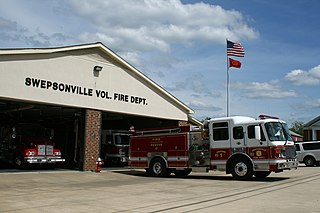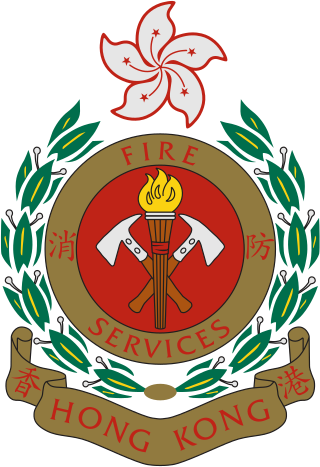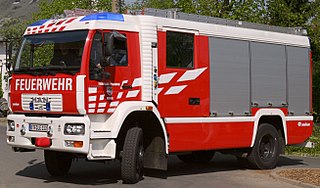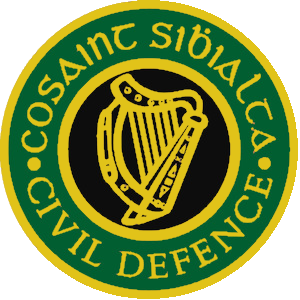Post-war
The Auxiliary Fire Service was reformed in 1948 alongside the Civil Defence Corps, starting initially with old National Fire Service equipment. However the role of the AFS was to provide mobile fire fighting columns that could be deployed to areas that had suffered a nuclear attack (it being assumed that the local fire fighting capability would most likely have been lost). The old equipment was not suitable for this task, so in the 1950s the AFS was reequipped. This included 1,000 Green Goddess (Bedford RLHZ Self Propelled Pump) fire engines, [4] Land Rovers, motorcycles and support vehicles such as pipe carriers, mobile kitchens, and foam and water carriers.
It was anticipated there would be some warning of the nuclear attack allowing some regular fire fighting equipment to join the AFS columns which would head to wherever they were required. These were substantial columns comprising many types of vehicles designed to be self-sufficient, so including motorcycles to go ahead and control traffic (e.g. AJS and Matchless), and carry messages, control vehicles such as the Land Rover and Austin Gipsy, field telephone equipment, fire fighting vehicles, pipe, water and foam carriers, as well as breakdown trucks and stores and catering. The AFS equipment was painted in British Standard 381C colour Deep Bronze Green, and carried large AFS door transfers.
Each fire station typically had an AFS division, and so AFS crews frequently attended fires and accidents alongside their regular colleagues. They provided significant assistance at some of the worst fires, such as that at Billingsgate Market and at Barking wood yard. AFS personnel were trained in firefighting by their own officers and with assistance from full-time fire officers. Many were trained to the St John Ambulance Higher First Aider Certificate standard – often proving invaluable at major incidents involving injury.
The Green Goddesses were used in two forms, initially a 4×2 (two-wheel drive) version based on the Bedford SHZ chassis powered by a 6-cylinder 110-brake-horsepower (82-kilowatt) Beford petrol engine, carrying 400 imperial gallons (1,800 litres) of water and a 1,000 imp gal/min (4,500 L/min) Sigmund FN4 centrifugal pump. Later versions were based on the Bedford 4×4 RLHZ chassis, with the same pump and 300 imp gal (1,400 L) water capacity. Their primary role was as a mobile pump, and they could combine to provide a pipe relay over great distances when connected using 6-inch (150 mm) hose, supplying 1,000 imp gal/min (4,500 L/min) from one location to another, often the seat of a major fire. An inflatable dam was often used as the source for the relay, usually fed by using several light portable pumps powered by Coventry Climax FWP engines. Water could be drawn from "open water" supplies (rivers, lakes or reservoirs) by a Transportable Water Unit more commonly known as "Bikini Units". These were floated on a raft so they could draw directly from a water and also use water under pressure to propel the raft.
The AFS (and the Civil Defence Corps) has never had any connection with any of the British armed forces, even though they used the same bronze-green paint colour. Although the supply of vehicles and equipment to both came via the Ministry of Supply, the AFS equipment was civilian registered and not military registered. When the AFS was disbanded in 1968, the 4×2 Green Goddess units were auctioned, but the 4×4 version and Land Rovers and Austin Gipsys were mothballed against some future emergency. Local authority fire brigades could borrow Home Office vehicles to meet exceptional needs, and 500 Green Goddesses were brought out of retirement during the drought of 1976. The government used Army and Royal Navy personnel to man and operate fire appliances during the firemen's strikes, including Home Office equipment brought out of storage. The Fire Service Circular [5] in 1984 showed 1,079 Green Goddess emergency pumps, 142 Land Rovers/Austin Gipsies, 369 trucks and 2,321 lightweight portable hose pumps held in reserve. Although they had been stored all over the UK, from 1992 the Green Goddess pumps were all relocated to the large TNT Truck Care depot in Marchington, Staffordshire. In 1997 a total of 96 low-mileage Austin Gipsies were auctioned by the Home Office at Measham, and the Green Goddesses and remaining Gipsies were sold in 2005, many going to fire brigades in developing countries, particularly in Africa, some to preservation.

The 2002–2003 UK firefighter dispute was a period of nationwide strike action which began when the Fire Brigades Union (FBU) voted to strike in an attempt to secure better salaries. The FBU demanded a 39 percent increase in pay, which would have brought the average firefighter's wage to around £30,000. It balloted its members for a strike in late 2002 and the industrial action began in November. It was the first nationwide firefighters' strike in the UK since 1977. The strike was led by FBU General Secretary Andy Gilchrist.

A fire engine, fire truck, or fire ambulance is a vehicle, usually a specially-designed or modified truck, that functions as a firefighting apparatus. The primary purposes of a fire engine include transporting firefighters and water to an incident as well as carrying equipment for firefighting operations in a fire drill. Some fire engines have specialized functions, such as wildfire suppression and aircraft rescue and firefighting, and may also carry equipment for technical rescue.

The Green Goddess is the colloquial name for the RLHZ Self Propelled Pump manufactured by Bedford Vehicles, a fire engine used originally by the Auxiliary Fire Service (AFS), and latterly held in reserve by the Home Office until 2004, and available when required to deal with exceptional events, including being operated by the British Armed Forces during fire-fighters’ strikes. These green-painted vehicles were built between 1953 and 1956 for the AFS. The design was based on a Bedford RL series British military truck.

A volunteer fire department (VFD) is a fire department of volunteers who perform fire suppression and other related emergency services for a local jurisdiction. Volunteer and retained (on-call) firefighters are expected to be on call to respond to emergency calls for long periods of time, and are summoned to the fire station when their services are needed. They are also expected to attend other non-emergency duties as well.

A fireboat or fire-float is a specialized watercraft with pumps and nozzles designed for fighting shoreline and shipboard fires. The first fireboats, dating to the late 18th century, were tugboats, retrofitted with firefighting equipment. Older designs derived from tugboats and modern fireboats more closely resembling seafaring ships can both be found in service today. Some departments would give their multi-purpose craft the title of "fireboat" also.

The South Australian Country Fire Service is a volunteer based fire service in the Australian state of South Australia. The CFS has responsibility as the Control Agency for firefighting, rescues and hazardous materials and inland waterways in the country regions of South Australia. Its official mission is "To protect life, property and the environment from fire and other emergencies whilst protecting and supporting our personnel and continuously improving."

The Hong Kong Fire Services Department is an emergency service responsible for firefighting and rescue on land and sea. It also provides an emergency ambulance service for the sick and the injured and gives fire protection advice to the public. It is under the Secretary for Security who heads the Security Bureau.

The London Fire Brigade (LFB) is the fire and rescue service for London, the capital of the United Kingdom. It was formed by the Metropolitan Fire Brigade Act 1865, under the leadership of superintendent Eyre Massey Shaw. It has 5,992 staff, including 5,096 operational firefighters and officers based at 102 fire stations.
The New Zealand Fire Service was New Zealand's main firefighting body from 1 April 1976 until 1 July 2017 – at which point it was dissolved and incorporated into the new Fire and Emergency New Zealand.

The Feuerwehr is a number of German fire departments. The responsible bodies for operating and equipping fire departments are the German communities ("Gemeinden") and cities ("Städte"). By law, they are required to operate fire-fighting forces. In cities, this is usually performed by the Fire Prevention Bureau, one of the higher-ranking authorities.

A wildland fire engine or brush truck is a fire engine specifically designed to assist in fighting wildfires by transporting firefighters to the scene and providing them with access to the fire, along with water or other equipment. There are multiple types of wildfire apparatus which are used in different scenarios. According to the U.S. National Fire Protection Association, if the apparatus will be used primarily for outdoor and wildland responses, then it is to be considered a wildland fire apparatus and must conform to NFPA 1906.

Civil Defence Ireland is the national civil defence organisation of Ireland. It is a statutory agency of the Irish Department of Defence and is administered by local authorities. It was established in 1951 in response to the threat of nuclear disaster posed by the atomic bomb following World War II. Today it is an emergency response and rescue agency whose purpose is to provide aid, assistance and relief in times of emergency or natural disaster. It may also support primary emergency response agencies namely the Garda Síochána, HSE National Ambulance Service, and local authority fire services when requested. Civil Defence Ireland consists almost entirely of volunteers, numbering 2500 as of May 2023.

The Bedford RL was the British military's main medium lorry, built by Bedford from the mid-1950s until the late 1960s. The lorry was based on the civilian Bedford S type, first introduced in 1950. They superseded the Bedford QL, and were in turn superseded by the Bedford MK/MJ.

Fire services in the United Kingdom use a variety of fire appliances, which perform a wide range of general and specialised roles and fit into several distinct categories. Contemporary fire appliances carry a multitude of equipment and firefighting media to deal with different types of emergencies ranging from fires, rescues, vehicle extrication, floods, salvage, casualty and trauma care.
Godiva Fire Pumps was an offshoot from Coventry Climax, directed by Charles Pelham Lee, son of Leonard Pelham Lee.

The Isle of Man Civil Defence Corps is one of the five emergency services maintained by the Isle of Man Government, to provide a range of emergency responses on the Isle of Man, an independent Crown dependency located in the Irish Sea between England and Ireland. The Corps operates under the Department of Home Affairs.
The Belfast Fire Brigade came into existence in 1800, and until 1861 was managed jointly with the local police service. It then provided a dedicated firefighting service to the people of the city of Belfast until its amalgamation with the Northern Ireland Fire Authority on 1 October 1973, when it became the Fire Authority for Northern Ireland, today the Northern Ireland Fire and Rescue Service.

The Penrith Museum of Fire is an Australian firefighting museum that contains heritage-listed former operating and stored for preservation fire service vehicles located in Penrith, Sydney, Australia. The provenance of the firefighting vehicles date from 1841 to 1998. The fleet of vehicles was added to the New South Wales State Heritage Register on 25 February 2013.

The Berlin Fire Brigade is the fire and emergency medical service for Berlin, Germany. As well as firefighting, the Berlin Fire Brigade provides fire prevention, technical rescue services, emergency medical services, and assistance in case of chemical, biological, radioactive and nuclear hazards.

The Dennis DF series was a range of heavy-duty fire engine chassis produced by Hestair Dennis from 1979 to the early 1990s. Based on the Dennis RS/SS series, the DF has a 16,260 kg (35,850 lb) gross vehicle weight, and was produced primarily as a base for turntable ladder appliances or tanker units carrying either foam or water.


















